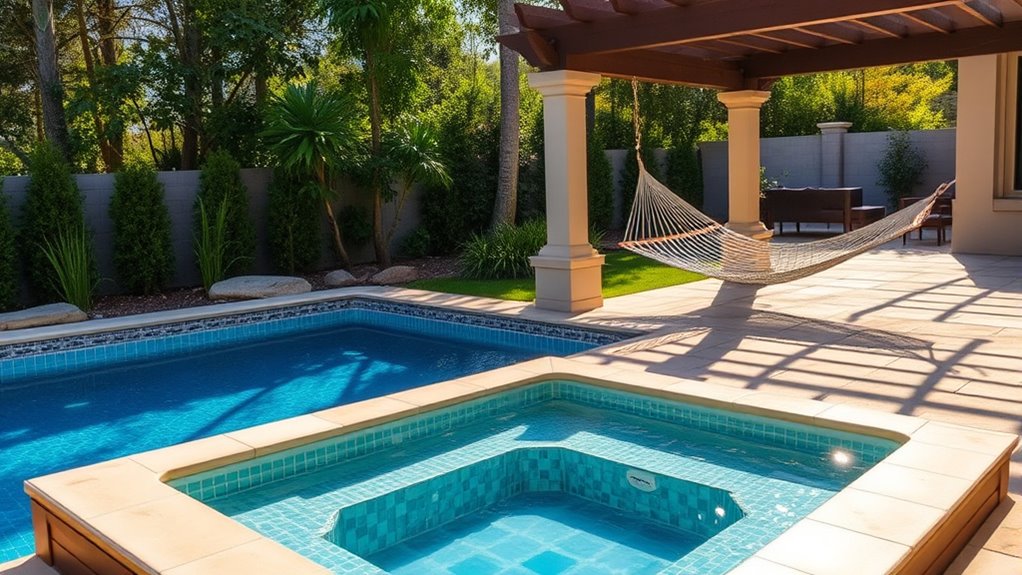If you’re looking for an energy-efficient, cost-effective solution that saves space, a swim spa might suit your lifestyle by combining swimming, relaxation, and water exercises in one compact unit. However, if you want larger swimming areas for social gatherings or family fun, a traditional pool could better meet your needs, despite higher costs. To find out which option aligns best with your preferences and space, explore the details below.
Key Takeaways
- Swim spas are energy-efficient, offering lower operating costs compared to larger traditional pools.
- They are more affordable and quicker to install, ideal for limited spaces and indoor setups.
- Swim spas blend swimming, water exercise, and relaxation, suitable for versatile lifestyles.
- Traditional pools provide larger areas for social gatherings and extensive aquatic activities.
- Long-term savings, maintenance, and space considerations help determine the best fit for your needs.

When choosing between swim spas and traditional pools, you’re weighing options that each offer unique benefits for your home and lifestyle. One of the key factors to contemplate is energy efficiency. Swim spas tend to be more energy-efficient because they use advanced filtration systems and smaller water volumes, which require less heating and running costs over time. Traditional pools, especially larger ones, often consume more energy due to their size, heating requirements, and more extensive filtration systems. If you’re looking to save on utility bills and reduce your environmental impact, a swim spa might be the smarter choice. Plus, because swim spas are designed with energy-efficient components, they often come with lower ongoing operational costs, making them a cost-effective investment in the long run.
Swim spas are more energy-efficient and cost-effective over time compared to traditional pools.
Installation costs are another critical consideration. Generally, swim spas have lower installation costs compared to traditional pools. They’re smaller and more compact, which means less excavation, fewer construction materials, and shorter setup times. You can often install a swim spa in a backyard corner or even indoors, reducing the need for extensive landscaping or structural modifications. Traditional pools, on the other hand, usually require significant excavation, concrete work, and extensive plumbing, which can quickly escalate the total installation expenses. If budget constraints are a concern, a swim spa offers a more affordable entry point, with the added benefit of quicker installation times. This makes them particularly appealing if you want to enjoy your new water feature sooner rather than later.
Beyond costs, think about how each option fits your lifestyle. Swim spas are versatile—they combine the benefits of a pool and a hot tub in one unit, allowing for swimming, water aerobics, or relaxation, all in a compact space. They’re ideal if you want to maximize functionality without dedicating a large area to a traditional pool. Traditional pools offer a larger swimming area, which is great for social gatherings, family fun, or serious lap swimming. If you have the space and desire a more expansive aquatic environment, a traditional pool might align better with your needs. Additionally, considering the contrast ratio of your pool or spa can significantly impact the visual quality and enjoyment of your aquatic setup, especially in darker or mood-lit environments. Ultimately, your choice depends on your priorities: if you want energy efficiency, lower installation costs, and versatility, a swim spa could be the perfect fit. If you prefer a larger swimming area and are prepared for higher initial costs and maintenance, a traditional pool might be more suitable. Consider how each option complements your lifestyle, budget, and long-term goals to make the best decision.
Frequently Asked Questions
Can Swim Spas Be Installed Indoors?
Yes, you can install swim spas indoors, but you’ll need to take into account space and ventilation. Indoor installation requires ample room for setup and proper airflow to prevent humidity buildup and mold. Make sure your space can handle the weight and plumbing needs of the swim spa. Consulting professionals ensures you meet safety codes and have adequate ventilation, making indoor swim spa use comfortable and sustainable.
How Energy-Efficient Are Swim Spas Compared to Pools?
Swim spas are generally more energy-efficient than traditional pools, offering significant energy savings over time. They tend to heat up faster and retain heat better, reducing heating costs. When considering a cost comparison, you’ll find that swim spas often have lower operating expenses due to smaller size and efficient insulation. This makes them a practical choice if you’re looking to enjoy water exercise without high energy bills.
What Is the Lifespan of a Typical Swim Spa?
Think of your swim spa as a trusty companion that can last for years. Typically, a swim spa’s lifespan spans 8 to 15 years, depending on spa durability and how well you maintain it. Factors like water chemistry, usage, and quality of materials influence its longevity. With proper care, your swim spa can be a reliable oasis for relaxation and exercise, standing the test of time like a well-built ship on calm waters.
Are Swim Spas Suitable for All Climates?
You might wonder if swim spas work well in all climates. The good news is, many swim spas offer climate adaptability and seasonal usability features, like insulated shells and heating systems. This means you can enjoy your swim spa year-round, even in colder or hotter weather. Just make certain you choose one with proper insulation and a reliable heating option, so you can swim comfortably regardless of the season.
Do Swim Spas Require Regular Professional Maintenance?
Think of your swim spa as a car—you’ll need to give it regular care. Yes, it requires professional maintenance to keep the chemical balance spot-on and ensure smooth operation. Seasonal upkeep might involve winterizing or cleaning, but overall, maintaining your swim spa isn’t a full-time job. Regular professional attention helps prevent issues, keeping your swim spa running efficiently and extending its lifespan, so you can enjoy swimming without worries.
Conclusion
Choosing between a swim spa and a traditional pool is like deciding whether you want a mini ocean or a backyard pond. A swim spa transforms your yard into a personal aquatic kingdom, where you can swim, relax, and exercise anytime, rain or shine. It’s not just a pool—it’s your own aquatic adventure land, fitting seamlessly into your lifestyle. Whichever you pick, you’re about to turn your outdoor space into the ultimate water wonderland!










